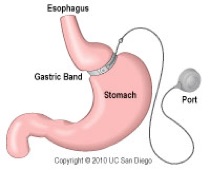
Bart Decadt
Consultant Laparoscopic Bariatric
& Upper GI Surgeon





Contact Private Secretary (Barbara Dawson)
Telephone 0161 440 9997 Fax 0161 440 8818 Mobile 07802 445558




Gastric Band
How does a Gastric Band work?
In this procedure the capacity of the stomach is made smaller by placing an inflatable silicone band around the upper part of the stomach to create a new small pouch, which can hold only a small amount of food. The band slows down the passage of food from the pouch to the rest of the stomach, which will make you feel full faster and reduces food consumption and calories intake.
How is the procedure performed?
The band is inserted using a general anaesthetic laparoscopically (keyhole surgery using small incisions in the abdomen) to encircle the upper part of the stomach and is connected by a tube to a small port that is placed under the skin of your abdomen.
How is the Band adjusted?
The gastric band is designed in a way that can be adjusted to change the size of the stomach pouch by injecting or aspirating saline into the access port. The first band inflation (band fill) is done 4 - 6 weeks after surgery . Usually you need about 2 to 5 band fills in total during the first 2 years (which are all included in the package price).
Who is suitable for a Gastric Band?
Gastric banding surgery is possible when appropriate non-surgical measures have been tried but failed to achieve or maintain adequate, clinically beneficial weight loss in patients.
Here’s an example: BMI is 40 kg/m2 or more OR between 35-40 kg/m2 in association with other significant disease (for example, type 2 diabetes, heart disease or high blood pressure).
It is also recommended as a first-line option (instead of lifestyle interventions or drug treatment) for adults with a BMI of more than 50 kg/m2 in whom surgical intervention is considered appropriate (National Institute for Clinical Excellence). In March 2011, The International Diabetes Federation recommended bariatric surgery to patients with BMI 30 kg/m2 (Asians from BMI 27.5 kg/m2) if their diabetes was poorly controlled. However, the need for surgery to aid weight loss is dependent on discussion with the bariatric team who will provide you expert and comprehensive advice.
Does the Band last for a long time?
Our experience is limited to the years since 1993 when the first gastric band was fitted. However, a gastric band is designed to remain permanently. It is made entirely of biocompatible materials, so the band can stay in the patient’s body without causing harm.
Is Gastric Band surgery safe?
A Gastric Band operation is simple, safe and effective.
How much weight will I lose with the Gastric Band?
The weight loss achieved with the band is significant (on average 40-50% of the excess weight is lost over 12-24 months). Although you might feel full with a small meal, the band doesn’t reduce hunger fully and does not stop people from snacking or taking additional calories through sweets and high-calorie drinks such as alcohol. It is essential therefore that one should control these aspects of eating and drinking as well as exercise in order to achieve the desired result. Otherwise, 1-in-10 people could fail to achieve any substantial weight loss.
What are the benefits of a Gastric Band?
Significant weight loss up to 40-50% of excess body weight within 2 years. Marked improvement or resolution in health conditions related to obesity, particularly type-2 diabetes (approximately 50% chance of resolution), hypertension (60% chance of resolution) gastro-oesophageal reflux, obstructive sleep apnoea (75% chance of resolution), asthma, liver disease, high cholesterol, and painful osteoarthritis.
There will be an improvement in overall physical and psychological health, and compared with other types of weight loss surgery, adjustable gastric banding is fully reversible by keyhole surgery, adjustable, less invasive, takes less operating time (average, 25 minutes), can be performed as a day case procedure, does not interfere with absorption so vitamin deficiencies are less likely to occur as well as lower risk of dumping syndrome.
What are the risks of a Gastric Band?
Although this operation is safe and effective, within 5 years, 1-in-10 people may need another operation to fix problems including:
Pouch dilatation : affects up to 8% of patients, requiring the band to be either re-positioned or removed.
Band Erosion : affects 1% of patients, requiring the band to be removed and the hole in the stomach closed.
Port or Tube Leaking : can be replaced with a new Port or Tube.
Port Infection : requires the port to be removed and a new port to be placed 3 months later.
Severe Acid Reflux, and rarely Oesophageal (gullet) Dilatation: requires the band to be fully deflated and preferably removed. It is not advisable to have a gastric band if you already suffer with severe acid reflux.
Will I regain weight after surgery?
Approximately 1-in-5 people could regain the weight they lost within 5 years after surgery, usually linked to a change in dietary habits, less physical activity, less commitment or a combination of these three factors. Indeed, the success of this type of surgery depends of continuing commitment and motivation to achieve long-lasting weight loss.


CALCULATE YOUR BMI
THE PATIENT JOURNEY

All Enquiries
0161 440 9997







































request a quote
to request a quote or a call to discuss your surgical needs






to go to the NBSR website


“I enjoy attending the monthly support group sessions where I am helped by others who have experienced weight loss surgery..”






MBS (Manchester Bariatric Services)






